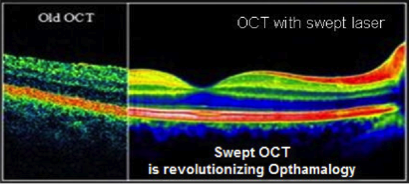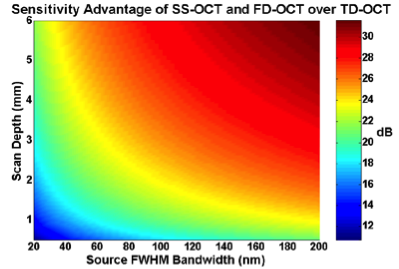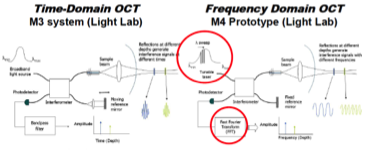Three Generations of OCT |
|
|
OCT was invented in 1991. First generation OCT used a physical movement of the fiber or optical path to allow the image to “see” down into the tissue. This time-based movement led to it being referred to as time-domain OCT, or TD-OCT. Time domain OCT has many limitations, including relatively slow speed. This gave way to a second generation, spectral domain OCT, or SD-OCT. With SD-OCT, the ability to “see” down into the tissue comes from looking sequentially at different wavelengths of a broadband optical source. This increased speed and improved image quality led to a wholesale change from TD-OCT to SD-OCT. Third-generation OCT uses a swept wavelength tunable laser. Instead of only looking at one small slice of the output of a broadband source (which naturally limits the signal to noise), all of the light is collapsed into a single wavelength and that wavelength is swept across a range of wavelengths. This substantially increases signal-to-noise and can increase speed and other attributes like coherence length. The difference in image quality can be substantial, as illustrated in the top image at the right. The major delay in attaining commercialization of third generation OCT has been availability of swept laser sources with high quality optical signals, high linearity sweeps, fast sweeping, high reliability, and low cost.
Additional general information:
Additional technical information: |
The faster measurement speeds of third generation swept-source OCT generate higher image quality and enable high definition and 3D imaging.
Sensitivity advantage of SS-OCT and FD-OCT compared with conventional TD-OCTwith a Gaussian source at 1300 nm. Sensitivity advantage is defined as SNRsdoct/SNRtdoct and expressed in dB. |
|
System architectures of first generation TD-OCT |
|






